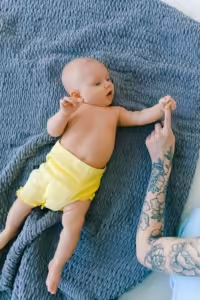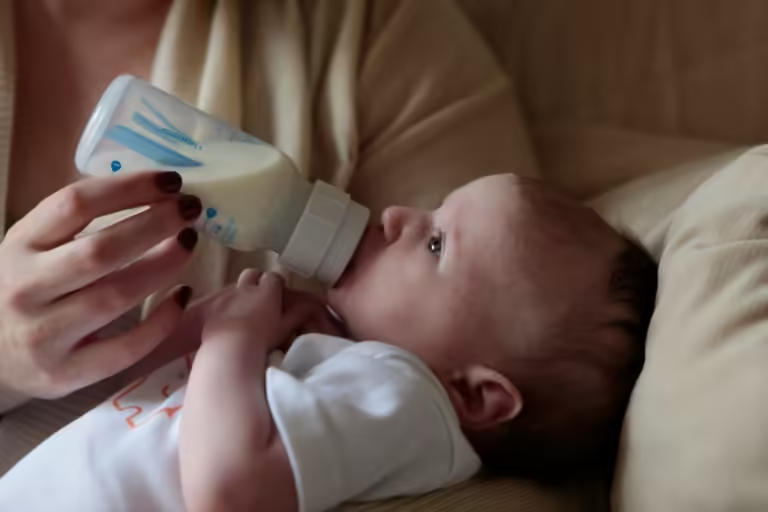As a dedicated author and researcher in the realm of infant and child sleep, I’ve spent countless hours delving into the science and practicalities of helping our little ones develop healthy sleep habits. One of the most common questions I encounter from exhausted parents is: “How can I teach my baby to fall asleep on their own?” It’s a question that resonates deeply, as the ability of a child to fall asleep independently is not just about parental sanity (though that’s a huge perk!), it’s fundamentally about fostering a crucial life skill that will benefit them for years to come.
Based on my research, including insights from Alexis Dubief’s “Precious Little Sleep,” a comprehensive resource for modern parents, this article will provide you with an in-depth look at the methods, considerations, and nuances of teaching your baby to fall asleep independently.
Why Is Independent Sleep So Important?
Before we dive into the “how,” let’s explore the “why.” Why is independent sleep such a monumental milestone in your baby’s development? Imagine you’re drifting off to sleep, cozy and warm, and then suddenly you wake up in a completely different environment. Wouldn’t you be alarmed? This is similar to what babies experience when they fall asleep with assistance (like rocking or nursing) and then wake up alone. They’ve developed a sleep association, and when that association is missing, it can lead to frequent night wakings and difficulty falling back to sleep. Independent sleep breaks this cycle, allowing your child to navigate those natural sleep arousals without needing your intervention. Think of it like this: independent sleeper is much more developed than a dependent sleeper because this child can sleep in every circumstances and whenever he or she feels like it.
When Is the Right Time to Start?
So, when is the magical moment to embark on this sleep-teaching journey? While there’s no universal answer, research suggests that the sweet spot is generally between 2 to 4 months of age. This is the easiest time to work on teaching babies to fall asleep on their own. Here’s why:
- Circadian Rhythm Development: By this age, your baby’s circadian rhythm, the internal clock that regulates sleep, is starting to mature. This means their sleep patterns are becoming more predictable, with longer stretches of sleep at night.
- Soothing Tools: You can still safely and effectively utilize the “power tools” of sleep, such as swaddling, white noise, and pacifiers, which can be incredibly helpful during the transition.
- Malleability: Younger babies are more adaptable to changes in their sleep routines compared to older infants who have firmly established sleep associations.
- Fewer Sleep Disruptions: This age range often falls before common sleep setbacks like major developmental leaps, teething, or severe separation anxiety.
But what if your baby is older than 4 months? Don’t despair! While it might be a bit more challenging, it’s never too late to foster independent sleep.
Laying the Foundation for Success:
Before you implement any specific method, it’s crucial to create a solid foundation for sleep success. Think of it like building a house—you wouldn’t start with the roof, right?
- Consistent Bedtime: Aim for a regular bedtime, ideally around 7:00 to 8:00 p.m. for most babies. This helps regulate their body’s natural sleep-wake cycle.
- Predictable Bedtime Routine: Establish a calming routine that signals to your baby that sleep is approaching. This could include a bath, massage, reading, or quiet singing.
- Dark and Dull Sleep Environment: Ensure the room is dark, quiet, and free from stimulating distractions.
- Appropriate Wake Windows: Make sure your baby isn’t awake for too long before bedtime, as overtiredness can make falling asleep much harder.
Choosing the Right Method:
Now, let’s get to the heart of the matter: the methods. There are two primary approaches to teaching independent sleep:
1. SWAPs (Sleep With Assistance Plans):
These are gradual methods that involve parental presence and support. They are generally recommended for younger babies (under 6 months) or for parents who prefer a more hands-on approach. Here are a few popular SWAP techniques, as outlined in “Precious Little Sleep”:
- More Soothing: This involves maximizing the use of soothing tools like swaddling, white noise, and pacifiers to help your baby calm down and fall asleep.
- Fuss It Out (FIO): After your soothing routine, place your baby in their crib while they are still awake but drowsy. Give them a set amount of time (e.g., 15-20 minutes) to see if they can fall asleep on their own. If they don’t, you can intervene and soothe them again.
- The Double Take: Soothe your baby to sleep, place them in their crib, and then gently wake them up just a little bit. This helps them associate their crib with falling asleep.
- Gradual Weaning: This involves slowly reducing the amount of assistance you provide over time. For example, if you typically rock your baby to sleep, you might start by jiggling the crib instead, then gradually reduce the jiggling until they can fall asleep without it. Specific approaches within gradual weaning include strategies for:
- Motion Junkies: For babies who need motion to sleep (rocking, bouncing, etc.), you can gradually reduce the intensity and duration of the motion.
- Suckers: For babies who need to suck to sleep (pacifier, nursing, bottle), you can try the “pull-out method” (popping them off before they fall asleep) or the “anything-but method” (offering alternative soothing techniques).
- Cuddlers: For babies who need to be held to sleep, you can gradually increase the distance between you and your baby over time.
2. SLIP (Sleep Learning Independence Plan):
This method, often referred to as “cry it out” or “extinction,” involves putting your baby in their crib awake and allowing them to fall asleep on their own without parental intervention. While it can be more challenging emotionally for parents, it often leads to faster results.
- Key Considerations for SLIP:
- Age: Generally recommended for babies 4-6 months and older.
- Safety: Ensure a safe sleep environment.
- Commitment: This method requires a firm commitment from both parents.
- Consistency: Stick to the plan, even if it’s difficult.
- Variations of SLIP:
- Full Extinction: No check-ins.
- Graduated Extinction: Periodic check-ins at increasing intervals.
Which Method Is Right for You?
The best method depends on your baby’s age, temperament, and your own parenting style. There’s no one-size-fits-all answer. Some parents find that a gradual approach works best, while others prefer a more direct method. It’s essential to choose a plan that you feel comfortable with and that you can implement consistently.
What to Expect:
Teaching your baby to fall asleep independently is a process, and it won’t happen overnight. There will likely be some crying, especially with SLIP. It’s important to remember that crying is your baby’s way of communicating their frustration with the change. It doesn’t mean you’re harming them. In fact, studies have shown that sleep training does not have negative long-term effects on a child’s emotional development or attachment to their parents.
Troubleshooting:
What if you’ve tried a method for a reasonable amount of time (at least a week) and it’s not working? Here are a few things to consider:
- Consistency: Are you being 100% consistent with your chosen method?
- Timing: Is your baby’s bedtime and nap schedule appropriate for their age?
- Sleep Associations: Are there any lingering sleep associations that might be hindering progress?
- Medical Issues: Rule out any potential medical problems with your pediatrician.
Conclusion: You’ve Got This!
Teaching your baby to fall asleep independently is a journey, not a race. There will be ups and downs, triumphs and setbacks. But with patience, consistency, and the right knowledge, you can help your little one develop this crucial life skill. And when you do, you’ll all enjoy the benefits of restful nights and happy, well-rested days. Remember, you are not alone in this journey. Millions of parents have walked this path before you, and you can too. Trust your instincts, stay committed to your plan, and know that you are doing an amazing job. Your dedication to your child’s sleep health is a testament to your love and commitment as a parent. And remember what I said at the beginning of the article: you are an awesome parent!








